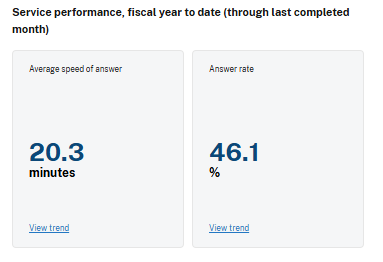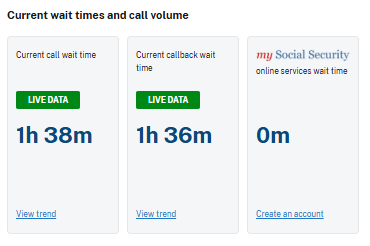Politics
SSA will get call wait times down to ‘single digits’ using AI, commissioner tells employees

The new head of the Social Security Administration is looking to get call wait times down to “single digits,” as part of this strategy to make the agency a “digital-first organization.”
An SSA official told Federal News Network that the agency’s monthly average call wait time dropped from 30 minutes in January to just about 12 minutes in May, when including callers who were given a “callback” option and didn’t have to remain on hold. SSA counts callbacks as a zero-minute wait time on its customer service metrics.
SSA Commissioner Frank Bisignano told employees in an all-hands meeting on Thursday that this has been the agency’s “best performance” since it started tracking these metrics. But said he plans to cut call wait times to a fraction of that using artificial intelligence tools.
“We’re going to get that thing down to single digits,” he said.
According to its 800 number performance dashboard, SSA’s average speed to answer calls, so far in fiscal 2025, is about 20 minutes, and less than half of all calls are answered. SSA answers about 390,000 calls each day.
An SSA employee, who spoke on condition of anonymity because they were not authorized to speak to the media, said about 70% of the agency’s callers are handled by callbacks.
At the time of reporting, the current wait time for a caller to reach an SSA representative is an hour and 38 minutes, if the caller chooses to remain on the line and doesn’t request a callback. For callers who do request a callback, the wait time is an hour and 36 minutes. More than 3,259 callers who didn’t opt for a callback are waiting on hold, and more than 22,000 callers are waiting for a callback.

Bisignano, a former Wall Street executive who led a financial tech company before joining the Trump administration, told employees he was “using AI before it was AI,” and oversaw financial organizations that processed a higher volume of payments than SSA does.
“Much bigger orgs, much bigger problems — but not as important. Can you see the difference? Here we do $1.5 trillion a year. In my last job, we did $2.5 trillion a day. This is more important than that, though,” he said.
“I understand the work you do. I may have not done it in the federal government, but it’s the same work,” he added.
Bisignano said he’s also focused on driving down a backlog of more than 6 million pending actions, and will tour a processing center in Queens, New York, on Friday.
An SSA official said these tasks at SSA processing centers “require further manual development and cannot be automated.”
“I’m going to go look at why we have 6.1 million items in backlog. That’s going away. We’ll use tools, we’ll keep rolling it out,” Bisignano said. “We’re going to win at field offices, we’re going to win at call centers. We’re going to win at processing centers. And I promise I will roll up my sleeves and work, because I actually know how to do this.”
Bisignano said SSA will be able to implement new tools and provide better customer service to beneficiaries within his first year on the job.
“This is a six-year term, but it’s going to be less than a one-year job. I’m not saying we’re going to be done with this in a year. Doesn’t mean I’m leaving in a year, but that’s my time frame for this. We’ve waited too long. There’s too many items in the backlog. There’s too many people waiting,” he said.
 SSA’s monthly average call wait time dropped from 30 minutes in January to just about 12 minutes in May. SSA Commissioner Frank Bisignano says the agency will get that wait time down to “single digits” through automation (Source: Social Security Administration)
SSA’s monthly average call wait time dropped from 30 minutes in January to just about 12 minutes in May. SSA Commissioner Frank Bisignano says the agency will get that wait time down to “single digits” through automation (Source: Social Security Administration)
SSA faces a growing workload. Former President Joe Biden signed the Social Security Fairness Act into law before leaving office in January, which gives larger monthly Social Security payments to 3 million public sector employees, retirees, spouses and surviving spouses.
The legislation eliminated the Windfall Elimination Provision and Government Pension Offset — two longstanding provisions of Social Security that reduce or eliminate benefits for certain government retirees, including Civil Service Retirement System annuitants, as well as teachers, firefighters, police officers and others who have worked in a public sector position.
An SSA official said delivering benefits to eligible individuals under the Social Security Fairness Act is a “priority workload,” and that the agency has used automation to expedite over $15.1 billion in “long-delayed retroactive payments” to more than 2.3 million individuals affected by WEP and GPO.
The official said SSA is “working to exceed” its estimate that this workload will be completed by early November, and is prioritizing 360,000 “more complex cases” that could not be processed through automation.
“These cases require additional time to manually update the records and pay both retroactive benefits and the new benefits amount,” the official said.
An SSA employee, who spoke on condition of anonymity because they were not authorized to speak to the media, told Federal News Network that the agency has started a “massive push” to process these 360,000 cases, “at the expense of other workloads.”
The agency official, however, said “SSA is not setting aside or deferring work as it prioritizes the SSFA cases.”
Bisignano told employees that SSA will overhaul its “MySSA” website, so that more beneficiaries — primarily retirees and Americans with disabilities — can get their questions answered online, instead of over the phone or in person at field offices.
“I want to know every transaction that’s done on the phone or in a field office that actually can be done on the web,” he said.
Before Bisignano took office, SSA under the Trump administration proposed and walked back several plans to limit the agency’s level of phone support to beneficiaries — forcing them to either seek help in-person at field offices or online.
Recent analysis from the Center on Budget and Policy Priorities finds that more than a quarter of senior citizens in the United States live more than an hour’s drive away from their nearest SSA field office, and more than half live 30 minutes away from the closest facility.
SSA in mid-April launched an AI “anti-fraud” check on all claims filed over the phone, which added an extra three days to processing.
SSA currently has its lowest level of staffing in 50 years, but Bisignano said the agency will increase its IT modernization spending to acquire tools that will make employees more productive.
“I’m glad that we’re in business together — and yes, it’s okay to call government business. We need to modernize everything we do. And yes, we’ll spend the money on it, and I can guarantee you that your job will become better,” he said.
SSA received the lowest employee satisfaction scores among large agencies last year, according to data compiled by the Partnership for Public Service’s Best Places to Work in the Federal Government scorecard.
Bisignano said SSA’s upcoming IT investments will give employees the tools they need to do their jobs effectively and will improve morale.
“We’re going to invest in you, we’re going to invest in your work. We’re going to invest in a client experience, if I may call it that. And when the employee experience improves and the client experience improves, you’re winning, right? We could be the model agency,” he said.
The Trump administration is proposing a $12.7 billion budget for SSA in fiscal 2026 — a flat budget, compared to its current spending levels. But Bisignano said SSA will secure the funding for IT modernization, because these improvements are a priority for President Donald Trump.
“It is very important to the President that Social Security performs great,” he said.
The post SSA will get call wait times down to ‘single digits’ using AI, commissioner tells employees first appeared on Federal News Network.
Politics
Black Lives Matter Activist in Boston Pleads Guilty to Federal Fraud Charges – Scammed Donors to Fund Her Lifestyle

Screencap of YouTube video.
A Black Lives Matter activist in Boston named Monica Cannon-Grant pleaded guilty to federal charges this week, admitting that she scammed donors and used their money to fund her own lavish lifestyle.
Cannon-Grant was previously held up as an admired figure. The city of Boston named her the Bostonian of the year at one point for her ‘social justice activism’ and she was even recognized by the Boston Celtics basketball team for her efforts.
She is now facing a minimum of two years in prison.
The New York Post reports:
BLM-linked activist admits conning donors to fund her lavish lifestyle
A once-celebrated Boston social activist has pleaded guilty to defrauding donors — including Black Lives Matter — out of thousands of dollars that she used as a personal piggy bank.
Monica Cannon-Grant, 44, pleaded guilty Monday to 18 counts of fraud-related crimes that she committed with her late husband while operating their Violence in Boston (VIB) activists group, according to the US Attorney’s Office in Massachusetts.
The activist scammed money — including $3,000 from a BLM group — while claiming it was to help feed children and run protests like one in 2020 over the murder of George Floyd and police violence.
Cannon-Grant also conned her way into getting $100,000 in federal pandemic-related unemployment benefits — which she used to pay off her personal auto loan and car insurance policy.
But she has now confessed to transferring funds to personal bank accounts to pay for rent, shopping sprees, delivery meals, visits to a nail salon — and even a summer vacation to Maryland.
Just amazing.
Monica Cannon-Grant stole from donors, scammed the government, and lived it up while preaching about oppression. BLM grift is the only nonprofit where fraud is part of the mission statement. https://t.co/ir3q9lqYrh
— Matthew Newgarden (@a_newgarden) September 23, 2025
BREAKING: BLM activist Monica Cannon-Grant pleads guilty to 27 fraud charges, misusing over $1M from Violence in Boston for personal gain. Echoes Sir Maejor Page’s $450K scam conviction. A wake-up call for nonprofit accountability. pic.twitter.com/N9vvD369gB
— (@pr0ud_americans) September 14, 2025
Here’s a local video report:
She should pay back every penny.
The post Black Lives Matter Activist in Boston Pleads Guilty to Federal Fraud Charges – Scammed Donors to Fund Her Lifestyle appeared first on The Gateway Pundit.
Politics
Keith Olbermann Backpedals Furiously With Apology for Threatening CNN’s Scott Jennings – Jennings Responds (VIDEO)

As the Gateway Pundit reported yesterday, former MSNBC host and generally unhinged leftist Keith Olbermann, appeared to threaten CNN’s conservative pundit Scott Jennings on Twitter saying, ‘You’re next motherf**ker.’
Well, Olbermann may have gotten a phone call or a visit from the FBI because today he walked back those comments with a full-throated apology.
RedState has an update:
To quickly recap, Scott Jennings, a Salem Media Network radio host and conservative CNN political commentator, reacted to breaking news on Monday that Kimmel had been reinstated by tweeting, “So basically his employer suspended him for being an insensitive pr**k, and we don’t live in an authoritarian regime? Got it.”
This enraged Olbermann, who proceeded to tweet what many, including Jennings, perceived to be a threat. “You’re next, motherf**ker. But keep mugging to the camera.” Jennings tagged Patel and included a screengrab of the tweets in response.
Though the FBI hasn’t commented as to whether an investigation was launched, Olbermann ostensibly appears to have thought twice about what he tweeted and deleted, apologizing profusely in tweets posted on Tuesday and claiming what he wrote was “misinterpreted”:
See Olbermann’s tweet below:
I apologize without reservation to @ScottJenningsKY
Yesterday I wrote and immediately deleted 2 responses to him about Kimmel because they could be misinterpreted as a threat to anything besides his career. I immediately replaced them with ones specifying what I actually meant. pic.twitter.com/SPWLb73nEk
— Keith Olbermann (@KeithOlbermann) September 23, 2025
I oppose and condemn political violence, and the threat of it. All times are the wrong time to leave even an inadvertent impression of it – but this time is especially wrong
I should've acknowledged the deletion and apologized yesterday. I'm sorry I delayed.
— Keith Olbermann (@KeithOlbermann) September 23, 2025
Scott Jennings, always a class act, offered this hilarious response:
SCOTT JENNINGS: “Marking myself SAFE from that NUT, Keith Olbermann!” pic.twitter.com/EYZX6vm5Oh
— Dustin Grage (@GrageDustin) September 23, 2025
Keith Olbermann really needs help. The guy is just so out of control.
The post Keith Olbermann Backpedals Furiously With Apology for Threatening CNN’s Scott Jennings – Jennings Responds (VIDEO) appeared first on The Gateway Pundit.
Politics
Where is Lance Twiggs? Kirk Assassin’s Transgender Lover Has Vanished

 Charlie Kirk assassin Tyler Robinson and roommate Lance Twiggs
Charlie Kirk assassin Tyler Robinson and roommate Lance Twiggs
Charlie Kirk assassin Tyler Robinson lived with his transgender partner – a male-to-female trans named Lance “Luna” Twiggs.
The FBI used Robinson’s texts with his transgender partner to solidify that Robinson was the assassin. Lance Twiggs has not been charged with any crime; however, federal authorities are still investigating.
Last week, Utah authorities released the text exchange between Tyler Robinson and his transgender lover, Lance Twiggs, sent shortly after Kirk’s assassination.
Utah County District Attorney Jeff Gray announced seven charges against Charlie Kirk assassin Tyler Robinson. They will also be seeking the death penalty.
Robinson was charged with:
– Count 1: Aggravated murder (capital offense)
– Count 2: Felony reckless discharge of a firearm causing bodily injury
– Count 3: Felony obstruction of justice for hiding the firearm
– Count 4: Felony obstruction of justice for discarding the clothing he wore during the shooting
– Count 5: Witness tampering for asking roommate to delete incriminating messages
– Count 6: Witness temperating for demanding trans roommate stay silent, and not speak to police
– Count 7: Commission of a violent offense in the presence of a child
Jeff Gray released the chilling texts between Tyler Robinson and his “love” Lance Twiggs.
Read the text exchange here:
 Tyler Robinson texts with transgender lover Lance Twiggs / 1
Tyler Robinson texts with transgender lover Lance Twiggs / 1
 Kirk assassin Tyler Robinson texts with transgender lover Lance Twiggs / 2
Kirk assassin Tyler Robinson texts with transgender lover Lance Twiggs / 2
Lance Twiggs was reportedly cooperating with the FBI, however, according to the Daily Mail he has seemingly vanished.
“If [Lance Twiggs] ever comes back, it will be in a body bag,” a neighbor said to the Daily Mail. “That’s not a threat – I’m just saying that there are so many people who want a piece of him he’d be mad to show his face in public again. This was a generational event.”
The Daily Mail reported:
The Trans boyfriend of Charlie Kirk’s alleged assassin has fled their former lovenest – and locals tell the Daily Mail they never want to see him again.
Lance Twiggs, 22, was led away for questioning when police swooped on the smart three-bed condo he shared with accused gunman Tyler Robinson, 22.
Shaken neighbors say the part time plumber has not been back to the $320,000 property in St. George, Utah – one declaring: ‘Good riddance. I never want to see either of them again.’
His beaten-up Infinity compact is still parked in his space with his work gear tossed across the back seat and a sandwich wrapper and a drink on the front passenger seat.
Upstairs lights have been left on for more than a week and notes and Amazon packages are piling up outside the home owned by Twiggs’s devout Mormon family.
The post Where is Lance Twiggs? Kirk Assassin’s Transgender Lover Has Vanished appeared first on The Gateway Pundit.
-

 Entertainment6 months ago
Entertainment6 months agoNew Kid and Family Movies in 2025: Calendar of Release Dates (Updating)
-

 Entertainment3 months ago
Entertainment3 months agoBrooklyn Mirage Has Been Quietly Co-Managed by Hedge Fund Manager Axar Capital Amid Reopening Drama
-
Tech6 months ago
The best sexting apps in 2025
-

 Entertainment5 months ago
Entertainment5 months agoKid and Family TV Shows in 2025: New Series & Season Premiere Dates (Updating)
-

 Tech7 months ago
Tech7 months agoEvery potential TikTok buyer we know about
-
Tech7 months ago
iOS 18.4 developer beta released — heres what you can expect
-

 Tech7 months ago
Tech7 months agoAre You an RSSMasher?
-

 Politics7 months ago
Politics7 months agoDOGE-ing toward the best Department of Defense ever



